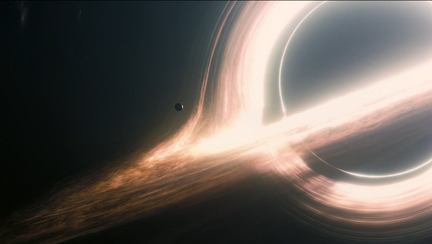No edit summary Tags: Visual edit apiedit |
m (Protected "Gargantua": inconsistencies ([edit=sysop] (indefinite) [move=sysop] (indefinite))) |
||
| (9 intermediate revisions by 9 users not shown) | |||
| Line 1: | Line 1: | ||
[[File:Black hole.png|thumb|432x432px|[[Miller (planet)|Miller]] orbiting Gargantua]] |
[[File:Black hole.png|thumb|432x432px|[[Miller (planet)|Miller]] orbiting Gargantua]] |
||
| − | Gargantua is a massive, rapidly spinning [ |
+ | Gargantua is a very massive, rapidly spinning [https://en.wikipedia.org/wiki/Black_hole black hole]. It is orbited by the planets [[Miller (planet)|Miller]] and [[Ice Planet|Mann]], as well as an unnamed neutron star. A main sequence star Pantagruel was located within a year's flight of Gargantua along with the habitable planet [[Edmunds (planet)|Edmunds]]. Gargantua is within a several week spaceflight of the Wormhole. |
In Kip Thorne's book, ''The Science of Interstellar, ''he mentions that Gargantua does not have a jet or a superheated blue accretion disk, indicating it has probably not devoured a star in millions of years. |
In Kip Thorne's book, ''The Science of Interstellar, ''he mentions that Gargantua does not have a jet or a superheated blue accretion disk, indicating it has probably not devoured a star in millions of years. |
||
==History == |
==History == |
||
| − | One of the first discoveries by NASA after sending initial probes through the Wormhole was likely Gargantua |
+ | One of the first discoveries by NASA after sending initial probes through the Wormhole was likely Gargantua. The Lazarus Missions engaged in very little study of Gargantua, but NASA's interstellar relay determined its gravitational influence on its planetary system. |
| − | The black hole Gargantua was used for a powered slingshot maneuver to facilitate [[Amelia Brand|Brand's]] arrival on Edmunds' planet, as the ''Endurance'' did not have enough fuel to reach Edmunds on its own. Gargantua also transported [http://interstellarfilm.wikia.com/wiki/Joseph_Cooper Cooper] and [http://interstellarfilm.wikia.com/wiki/TARS TARS] to the [[tesseract]], allowing them see the black hole's singularity and relay the quantum data to Cooper's daughter via morse code. Presumably, Gargantua is in or near to the center of the galaxy for which it resides. Due to the presence of large amounts of neutron stars and IMBHs (intermediate mass black holes) it could possibly be the |
+ | The black hole Gargantua was used for a powered slingshot maneuver to facilitate [[Amelia Brand|Brand's]] arrival on Edmunds' planet, as the ''Endurance'' did not have enough fuel to reach Edmunds on its own. Gargantua also transported [http://interstellarfilm.wikia.com/wiki/Joseph_Cooper Cooper] and [http://interstellarfilm.wikia.com/wiki/TARS TARS] to the [[tesseract]], allowing them see the black hole's singularity and relay the quantum data to Cooper's daughter via morse code. Presumably, Gargantua is in or near to the center of the galaxy for which it resides. Due to the presence of large amounts of neutron stars and IMBHs (intermediate mass black holes) it could possibly be the super-massive black hole of the home galaxy. |
== 2008 script == |
== 2008 script == |
||
| Line 16: | Line 16: | ||
==Links== |
==Links== |
||
* [http://concord.wikia.com/wiki/Planets_in_Science_Fiction Planets in Science Fiction] |
* [http://concord.wikia.com/wiki/Planets_in_Science_Fiction Planets in Science Fiction] |
||
| + | [[Category:Locations]] |
||
Latest revision as of 11:55, 13 October 2016

Miller orbiting Gargantua
Gargantua is a very massive, rapidly spinning black hole. It is orbited by the planets Miller and Mann, as well as an unnamed neutron star. A main sequence star Pantagruel was located within a year's flight of Gargantua along with the habitable planet Edmunds. Gargantua is within a several week spaceflight of the Wormhole.
In Kip Thorne's book, The Science of Interstellar, he mentions that Gargantua does not have a jet or a superheated blue accretion disk, indicating it has probably not devoured a star in millions of years.
History
One of the first discoveries by NASA after sending initial probes through the Wormhole was likely Gargantua. The Lazarus Missions engaged in very little study of Gargantua, but NASA's interstellar relay determined its gravitational influence on its planetary system.
The black hole Gargantua was used for a powered slingshot maneuver to facilitate Brand's arrival on Edmunds' planet, as the Endurance did not have enough fuel to reach Edmunds on its own. Gargantua also transported Cooper and TARS to the tesseract, allowing them see the black hole's singularity and relay the quantum data to Cooper's daughter via morse code. Presumably, Gargantua is in or near to the center of the galaxy for which it resides. Due to the presence of large amounts of neutron stars and IMBHs (intermediate mass black holes) it could possibly be the super-massive black hole of the home galaxy.
2008 script
The names of the neutron star and black hole most likely come from, The Life of Gargantua and of Pantagruel, a pentology of novels written in the 16th century by Francois Rabelais, featuring the adventures of two giants: Gargantua and his son Pantagruel. In the 2008 script, Pantagruel is actually a smaller black hole, with an icy planet orbiting it.
Extra details from 'The Science of Interstellar'
By calculations of Kip Thorne, Gargantua is about 100 million solar masses, placing it firmly as a supermassive black hole. Furthermore, it is an edge case in that it's somehow spun up to maximum minus 0.00000000000001 of the maximum, dragging space around it as it did so. Several of the visual effects were toned down severely from what it would actually look like; the event horizon would be warped and red and blue shifted. Miller's planet would have been under the level of the accretion disk and the event horizon would have covered 40% of the visible sky. By those same calculations, orbital transfers to Miller's would likely require slingshot maneuvers around intermediate mass black holes at both the start of maneuvers and at the end, as the energy requirements seemingly preclude other methods of getting the required energy. Partially alluded to in movie by the short reference to a neutron star being useful for slingshot maneuvers.